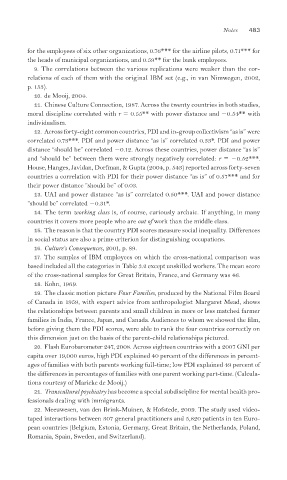Page 518 - Cultures and Organizations
P. 518
Notes 483
for the employees of six other organizations, 0.76*** for the airline pilots, 0.71*** for
the heads of municipal organizations, and 0.59** for the bank employees.
9. The correlations between the various replications were weaker than the cor-
relations of each of them with the original IBM set (e.g., in van Nimwegen, 2002,
p. 153).
10. de Mooij, 2004.
11. Chinese Culture Connection, 1987. Across the twenty countries in both studies,
moral discipline correlated with r 0.55** with power distance and 0.54** with
individualism.
12. Across forty-eight common countries, PDI and in-group collectivism “as is” were
correlated 0.73***. PDI and power distance “as is” correlated 0.33*. PDI and power
distance “should be” correlated 0.12. Across these countries, power distance “as is”
and “should be” between them were strongly negatively correlated: r 0.52***.
House, Hanges, Javidan, Dorfman, & Gupta (2004, p. 543) reported across forty-seven
countries a correlation with PDI for their power distance “as is” of 0.57*** and for
their power distance “should be” of 0.03.
13. UAI and power distance “as is” correlated 0.50***. UAI and power distance
“should be” correlated 0.31*.
14. The term working class is, of course, curiously archaic. If anything, in many
countries it covers more people who are out of work than the middle class.
15. The reason is that the country PDI scores measure social inequality. Differences
in social status are also a prime criterion for distinguishing occupations.
16. Culture’s Consequences, 2001, p. 89.
17. The samples of IBM employees on which the cross-national comparison was
based included all the categories in Table 3.2 except unskilled workers. The mean score
of the cross-national samples for Great Britain, France, and Germany was 46.
18. Kohn, 1969.
19. The classic motion picture Four Families, produced by the National Film Board
of Canada in 1959, with expert advice from anthropologist Margaret Mead, shows
the relationships between parents and small children in more or less matched farmer
families in India, France, Japan, and Canada. Audiences to whom we showed the fi lm,
before giving them the PDI scores, were able to rank the four countries correctly on
this dimension just on the basis of the parent-child relationships pictured.
20. Flash Eurobarometer 247, 2008. Across eighteen countries with a 2007 GNI per
capita over 19,000 euros, high PDI explained 40 percent of the differences in percent-
ages of families with both parents working full-time; low PDI explained 49 percent of
the differences in percentages of families with one parent working part-time. (Calcula-
tions courtesy of Marieke de Mooij.)
21. Transcultural psychiatry has become a special subdiscipline for mental health pro-
fessionals dealing with immigrants.
22. Meeuwesen, van den Brink-Muinen, & Hofstede, 2009. The study used video-
taped interactions between 307 general practitioners and 5,820 patients in ten Euro-
pean countries (Belgium, Estonia, Germany, Great Britain, the Netherlands, Poland,
Romania, Spain, Sweden, and Switzerland).

